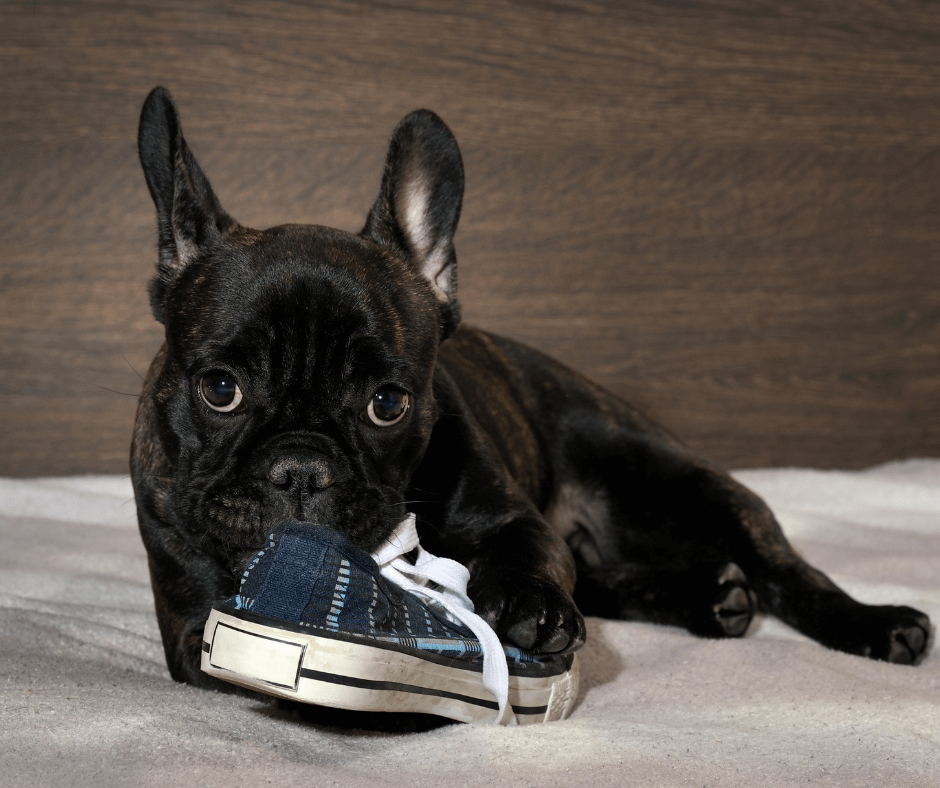5 Naughty Dog Behaviours

We all love a dog with perfect manners, don’t we? A dog that causes no trouble, and knows what their guardian expects. Then there is the other kind. You know, the shoe chewers, the jumpers, the naggers at mealtime… The carpet wetters. Here, we look at five naughty dog behaviours, what they mean, and ways to curb them.
1. Ignoring Commands
You say, ‘Sit.’ Your dog stares back blankly. You say, ‘Come.’ Your dog turns and walks the other way. Ignoring basic commands is one of our naughty dog behaviours. If your pup is young, they may need to train a while longer. If it has been some time since they learned their basic training, they may have simply forgotten. Either way, spend a few minutes every day re-training them, offering a treat to reward obedience. All dogs are different; some may never need reinforcement of training, some may always need the reminder. This writer’s shih-tzu cross refuses to obey any command without the promise of a treat.
2. Chewing Shoes
Or clothing, or furniture. Dogs love to chew, especially puppies. If the offender is a pup, this is a training opportunity. We all know that scolding isn’t the way to deal with naughty dog behaviour, and it can interfere with a developing bond. Give a firm command, ‘Leave,’ and replace the object with a chew toy.
Puppies and young dogs need your time and attention in order to learn what they can and cannot chew. If the chewer is an older dog, retraining in this way can be affective, but you may be faced with needing to be vigilant; put out of their reach anything that you don’t want chewed up.
Try crating to deal with furniture chewing when you are unable to be with your dog for longer periods of time, remembering to leave him something to chew on. Whenever you use dog crating remember to make sure they have plenty of time to exercise, and an opportunity to pee before going in.
3. Begging at the Dinner Table
Dogs that whine whenever food comes out are annoying to guardians and their guests, and that’s why it makes our list of naughty dog behaviours. While we love them, it’s important to maintain a strict rule of never feeding them from the table if you want to stamp out this behaviour. Feed your dog at the eating place you’ve set aside for them before you sit down to eat. Provide a chew stick to keep them busy, and give them your command to go to their bed. If these measures don’t work, try them again with the use of a crate.
4. Jumping up
Most dog behaviourists agree that the basis of a dog jumping up on people is attention. It is the quickest and easiest way to get pats and attention. It makes perfect sense if you think about it. To us, especially when they are puppies, it isn’t a big deal. To guests, particularly when they are fully grown, it’s not so cute. Not only is this naughty dog behaviour an uninvited activity, but their claws can unintentionally hurt. A small dog can easily knock over a toddler, and bigger dogs can cause a lot more harm.
We need to take responsibility. As soon as you first bring your pup home, be adamant that they are to receive no attention for jumping up, no matter how cute they are. Instruct guests to not reward your dog for jumping up. A simple technique to use from the beginning is to step away and turn your back on them. Give no verbal or eye contact, and continue this. Reward your dog for coming up to you or a guest without jumping up. Give them a treat and lots of pats and praise. In older dogs, consult a dog behaviourist before using the knee technique, which could really hurt your dog, and interfere with that special period of bonding.
World-renowned dog behaviourist Cesar Milan talks a lot about the dog pack mentality. He believes that as a dog owner, you must establish yourself as Pack Leader. A dog that jumps up at others is letting them know that they are pack leader. This is an entirely different approach, but interestingly, the remedy isn’t too different. Cesar says we must move our pup ‘out of the way in a calm-assertive manner,’ and that we must instruct our dog to sit when guests arrive. Pretty straight forward, then.
5. Peeing in the House
It happens. It’s a lazy day, you were up till late the night before, no one has taken the dog out for a wee. No one hears the whining cries to go out. And then pee appears on the rug. Accidents happen. What we’re talking about is the more frequent accidents that occur in the absence of a request to go out.
Successful toilet training results in your dog giving you a cue to go outside. There are reasons this fails, including anxiety or excitement and marking territory. If you have an anxious pup, the solution could be complex and you should seek the guidance of a dog behaviourist to help with their individual needs. If you suspect they are marking, or peeing in a spot previously peed on, you must have the area treated thoroughly with a product formulated to neutralise the odour. Keeping track of the time between wees is helpful, as well as close supervision when your dog is in an area of concern.
Is your dog a digger? Read Why Does My Dog Love to Dig?
Dogs are a gift. They are all unique with their own sets of wonderful and often amusing character traits. If we can teach our dogs to behave well in our homes, it will only enrich our lives with them for years to come.
